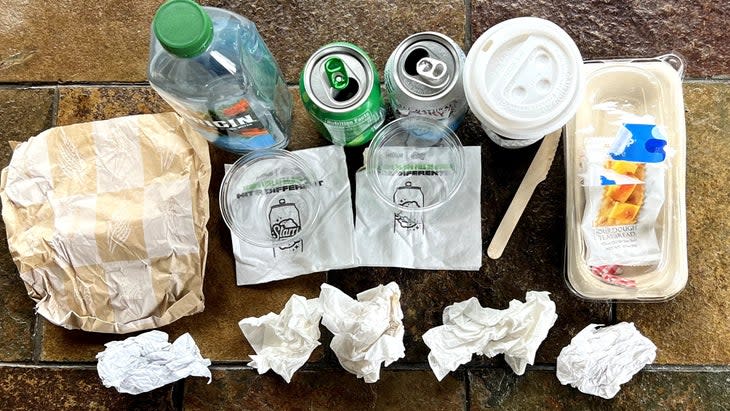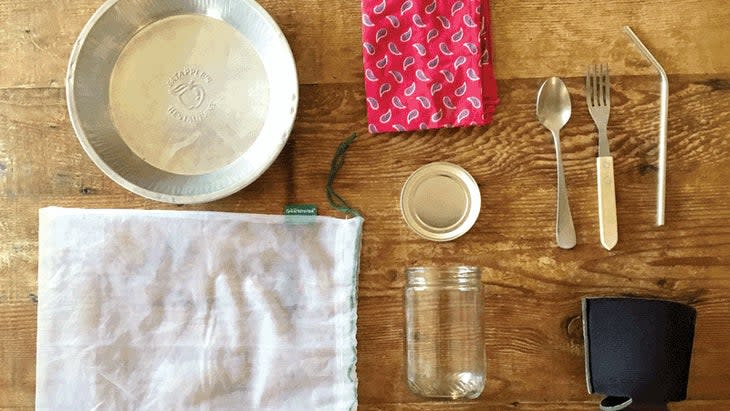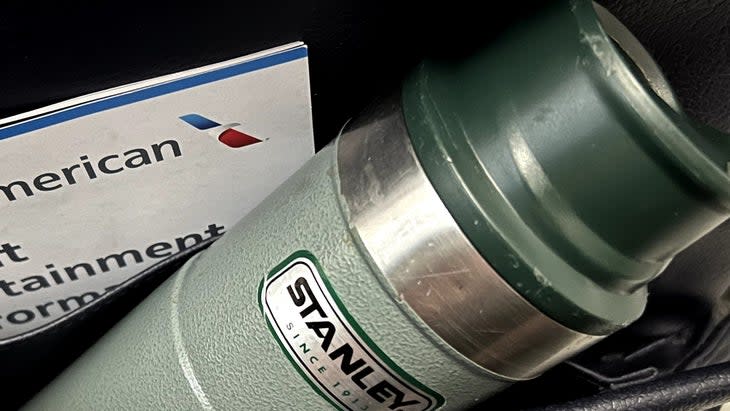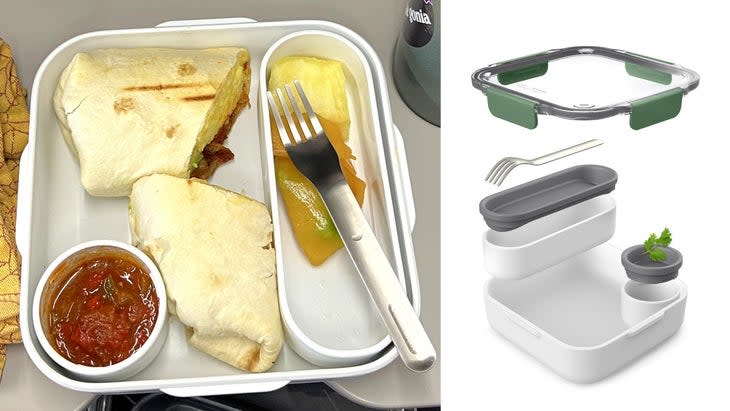Build Your Own Zero Waste Travel Kit
This article originally appeared on Outside
Doing right by the planet can make you happier, healthier, and--yes--wealthier. Outside's head of sustainability, Kristin Hostetter, explores small lifestyle tweaks that can make a big impact. Write to her at climateneutral-ish@outsideinc.com.
I've often wondered whether bringing a refillable water bottle while traveling is really a big deal. I'm just one person, so do my actions really matter in the grand scheme of things? How much waste does little old me create on a typical travel day? It can't be that bad, can it?
I decided to find out. Last week, I took a business trip from Boston to Salt Lake City. On my flight out, which connected through New York JFK, I left the zero-waste travel kit that I typically carry in my bag. I drank what I would normally drink, ate what I would normally eat. Washing my hands, I used paper towels instead of the air dryers . I tucked every single piece of waste I created into my carry-on. When I got to my hotel room and spread it out on the table, it was pretty appalling (see below).

In the U.S. there are approximately 2.3 million airline travelers per day. On my day of travel, I used seven single-use containers: one large plastic water bottle (it killed me to buy this), one disposable coffee cup and lid, two canned beverages and the two accompanying plastic cups. But let's be conservative and assume that the average person on the average travel day will use five items. That alone adds up to 11.5 million items of trash (and we're not even talking about food).
If only half of those people simply brought a reusable, dual-purpose (hot/cold) water bottle and refused to use single-use beverage containers, we're talking about keeping more than 5.75 million items out of the waste stream per day. Over the course of a year, that's an astounding 1,472,000,000 cups, lids, and bottles per year...for U.S. travelers alone!
So back to my original question. Does bringing a refillable water bottle while traveling really have an impact? Y E S.
"There are many things about the sustainability of air travel that we-as individuals-can't control," says Jackie Nunez, the advocacy and engagement manager at Plastic Pollution Coalition. She's talking about jet fuel burned, and noise, light, and air pollution. "But there's one thing we most certainly can: how much single-use trash we create as we cruise through the skies at 40,000 feet and schlep through airports."

With a little planning and resolve, you can get through an entire trip creating almost no excess waste, says Nunez, who calls herself an "urban backpacker," because she always carries her travel kit.
Over a Zoom call, I ask Nunez to give me some pro tips and we each show-and-tell’ed our travel kits. "The best part," she says, "is that you don't have to spend a dime to create one of your own. Between the kitchen and your camping gear, you probably already have everything you need to create a totally functional, basic zero waste travel kit."
How to Make Your Own Basic Zero Waste Travel Kit
A Satchel
Pretty much anything goes for this, as long as you make sure all your items fit inside. A cloth shopping bag or a stuff sack from your camping-gear collection works great.
Drinking Vessels
It baffles me to see folks buying $8 plastic bottles of Fiji water at airports. Why, why, why? Refill stations are everywhere! San Francisco International Airport actually banned the sale of single-use plastic water bottles in 2019, and has thus diverted many millions of plastic bottles from the waste stream.

An insulated steel bottle with a leak proof sipper lid is my favorite because it serves double duty for hot and cold drinks. I also pack a small metal cup for use on planes in case I want a glass of juice or wine.
If you like to use a straw, invest in a set of metal ones.
Dishware
"Kick off your adventure right by packing up your travel-day meal or meals in a reusable, sealable container [like a sandwich-sized Tupperware]," says Nunez. "Not only does it let you clean out your fridge before you leave and reduce your food waste, it'll save you money and taste just as good-if not better-than the airport fast food. And you have a leftover container to use at restaurants during your trip."

Me? I like to fancy things up a bit. The Black + Blum Lunch Box Original ($30) is an elegant, square, leakproof, 34-ounce box that includes a little sauce pot, a side dish compartment, and a fork. For my flight home from Salt Lake City, it was perfect for a breakfast burrito with salsa and a side of fruit.
Nunez includes a tin pie plate in her kit (a dish from your camp kit works well, too) and has perfected this slick move when she wants to order something to-go but avoid all the packaging: Just sit down and order in so you'll be served on the restaurant's washable dish. When the food arrives, transfer it to your plate and walk out (after paying, of course).
Cutlery
Grab a fork, spoon, and knife from your kitchen. Or buy a dedicated set at a garage sale or thrift shop. Remember: only butter knives will make it through TSA. A spork from your camp kit also does the trick. If you dig chopsticks, throw in a pair.
Cloth Napkin
A bandana also works well and both are washable in a hotel sink if needed.
Other Sustainable Travel Tips
These easy travel hacks will help you save waste.
> When you check in before the trip, download your digital ticket to your phone and avoid the paper one.
> If a restroom offers hand dryers, use them instead of paper towels. Or just shake and wipe your hands on your pants.
> If you need to eat on the go, look for a sit-down place that uses washable instead of disposable dishware. If you can't find one, try to walk away with as little trash as possible. I often say to the cashier, "I'm trying to reduce my single-use plastic waste. Would you please wrap my sandwich in paper, no bag, and skip extras like napkins, utensils, and condiments?"
> Choose a hotel with a good sustainability policy that has eliminated single-use plastic toiletries, like Marriott or Hyatt properties. It also only helps to pack your own toiletries like shampoo, conditioner, and soap, so you can leave the mini bottles in the hotel bathroom untouched.
> Decline daily housekeeping during your hotel stay to save on water and energy. Hang up your towels to air dry and avoid using single-use cups and coffee products. And, of course, ignore the free single-use water bottles in your room.

Kristin Hostetter is the head of sustainability at Outside Interactive, Inc. and the resident sustainability columnist on Outside Online. Six years ago she made a New Year's resolution to quit disposable coffee cups. After one crack-of-dawn flight in which she had to go without her beloved dark roast, she has never, ever forgotten her mug since.
For exclusive access to all of our fitness, gear, adventure, and travel stories, plus discounts on trips, events, and gear, sign up for Outside+ today.

